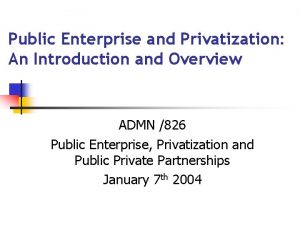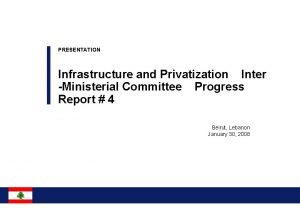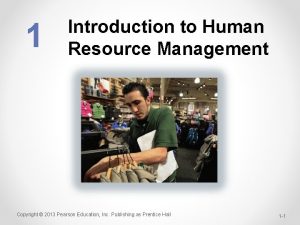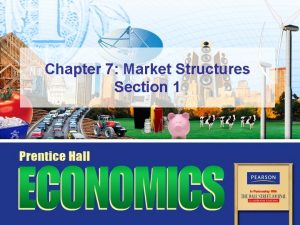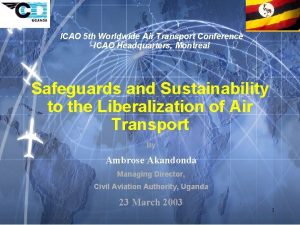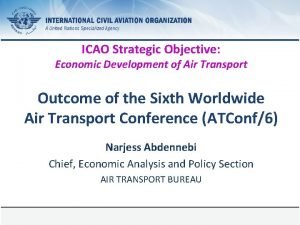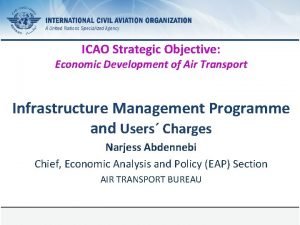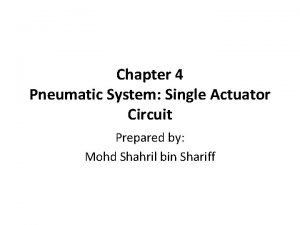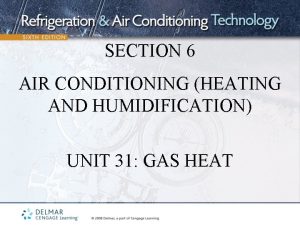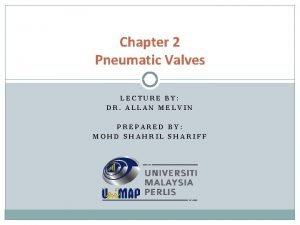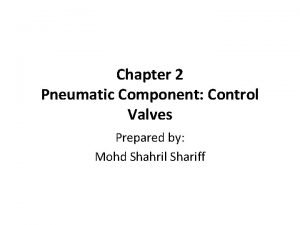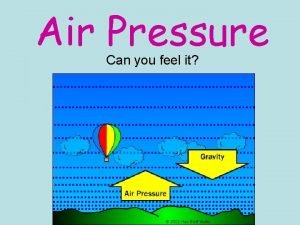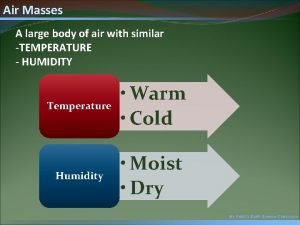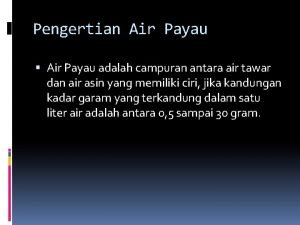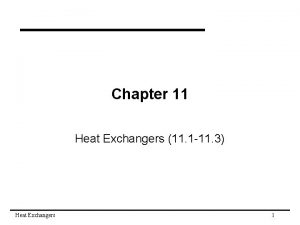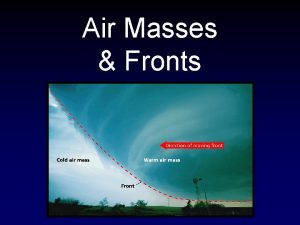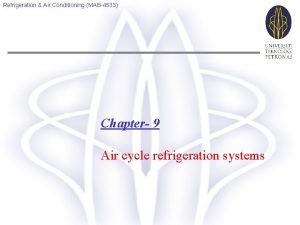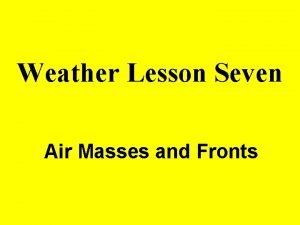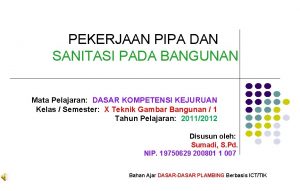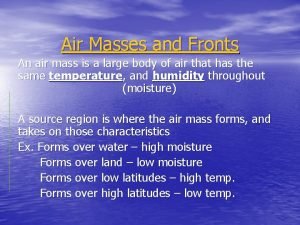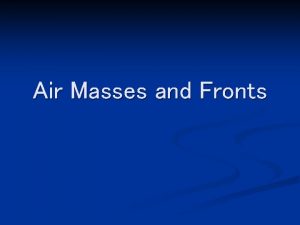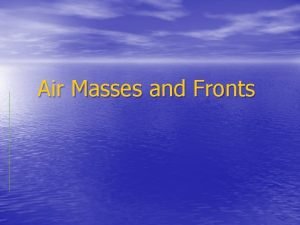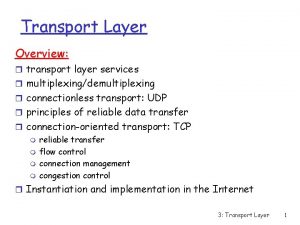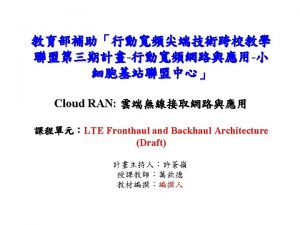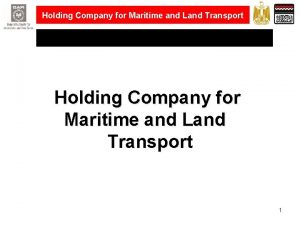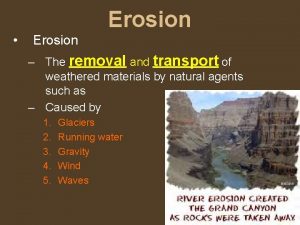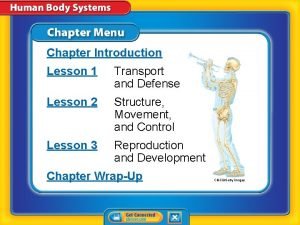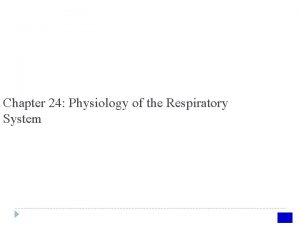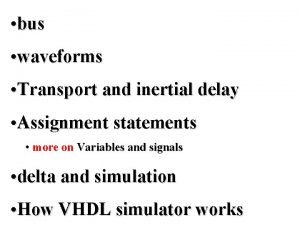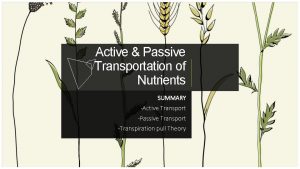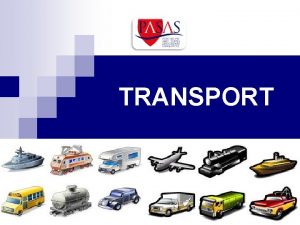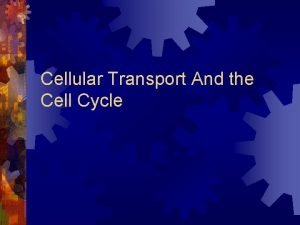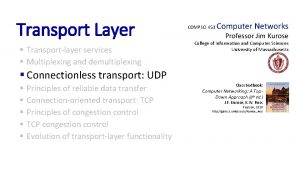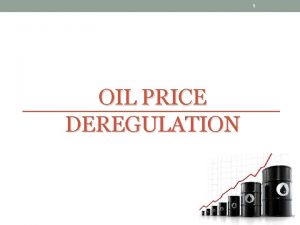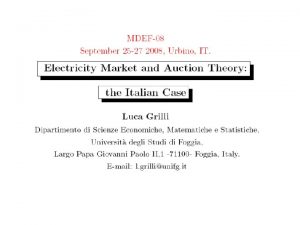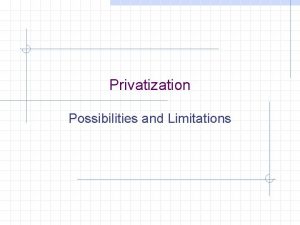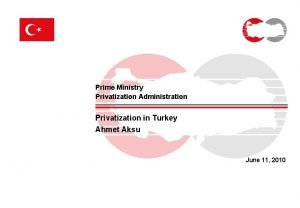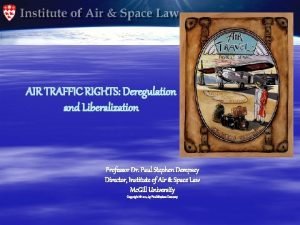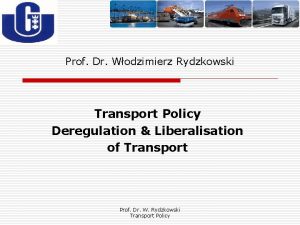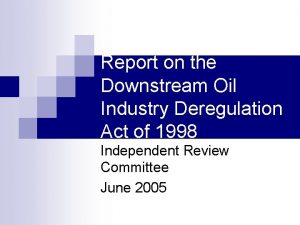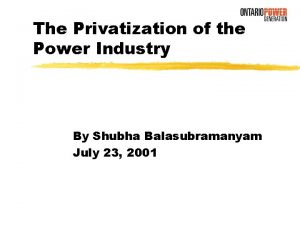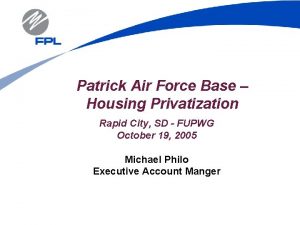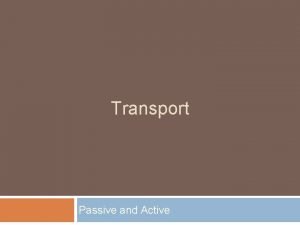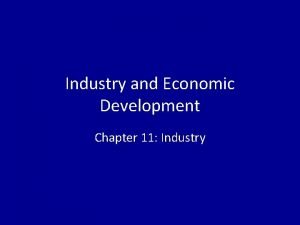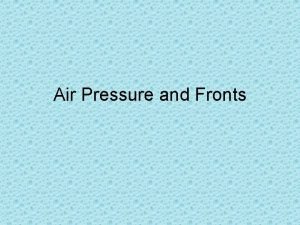Deregulation and Privatization of the Air Transport Industry











































































































- Slides: 107

Deregulation and Privatization of the Air Transport Industry Kenneth Button University Professor George Mason University June 2008

“Only the psychologically disturbed or inadequate want transport for its own sake. ” Denys Munby, 1968

Some quotes “These days no one can make money on the goddam airline business. The economics represent sheer hell” C. R. Smith American Airlines “People who invest in aviation are the biggest suckers in the world” David Neeleman, jet. Blu Airways, 1999 “If the Wright brothers were alive today Wilbur would have to fire Orville to reduce costs” Herb Kelleher, Southwest Airlines, 1994 “They don't realize that while you're sitting here talking, someone is f**king you. Changing a fare, changing a flight, moving something. There's no autopilot, and that's why I've seen a lot of guys come and go” Gordon Bethune, Continental Airlines, 2004 “There always going to be some stupid people who will invest in airlines” Kenneth Button, Washington Post, 2005

Institutions • Formal: laws, regulations, contracts • Informal: “ways of doing business, interpretation of laws • Personal: habit

Do institutions matter? • Coase said in Nobel speech: “These ex-communist countries are advised to move to a market economy, and their leaders wish to do so, but without the appropriate institutions no market economy of any significance is possible. ” • Matthews in his Royal Economic Society address said: “. . Economics of institutions has become one of the liveliest areas of our discipline. …institutions do matter…the determinants of institutions are susceptible to analysis by tools of economic theory”

Do institutions matter? However, Williamson points out: “we are still very ignorant about institutions” “Chief among the causes of ignorance is that institutions are very complex. That neo-classical economics was dismissive of institutions and much of organization theory lacked scientific ambitions have been contributing factors. ”

“New” institutional economics • Old institutional economics – – Descriptive Legalisic Historic Often negative (attacking neo-classical economics) • “New” institutional economics – Holistic approach to economics – Analytical in nature

Linkages between economic institutions

Characteristics of air transport • • Long/medium distance Fast and reliable (important for some types of freight) Highly flexible (spatially and temporally) Quick to put in place (relatively low fixed costs) Significant development about terminals Relatively secure (no track) Relatively safe Relatively easy to develop private/public structures

Airlines part of an air transport system

Air transport is a major industry • • 1, 600 million passengers a year 3. 9 million jobs $260 billion turnover 18, 000 aircraft 15 million kilometer network 10, 000 airports 130 billion revenue ton kilometers 30 million tons of freight

Further features of the global market • Large industry in its own right (1% of Western European GDP, more than 1% of US GDP) • Important for key modern industries (high-tech management flies 60% more than traditional industries) • Important for long term economic/political integration • Lubricant for the economic system • Half of tourists outside of Europe travel by air

Dimensions of economic benefits of air transport • • • Simulates macro economic growth Regional effects Access to remote regions Sector effects (e. g. tourism) Air cargo (high value goods) International markets Foreign exchange earnings Social cohesion Retaining family/social ties Cultural understanding

Air transport can benefit economic development • • Primary effects. (e. g. , building an airport) Secondary effects. (e. g. , running an airport) Tertiary effects. (e. g. , using an airport) Perpetuity effects. (e. g. , changing the economy)

Some studies of airport impacts • US MSAs - hub airport increases region’s employment by 12000 • Chicago O’Hare – 50% increase in traffic will increase employment in the region by 185, 000. • Atlanta - 264 foreign-based firms, direct international services was 3 rd most important thing in location • 57 companies in Europe – air transport network the 3 rd most important factor in location. • Zurich – 34% of firms considered the airport as ‘very important’ and 38% as ‘important’ as location factor. • Schiphol Airport (Netherlands) – 85, 000 jobs for the country.

Jobs and income from having a local airport (per million passengers) Jobs High Medium Low Economic Impact ($millions) Direct Total 2000 1500 750 225 75 35 8000 6000 2500 1600 650 130

Tourist growth ($millions) by destination 1995 Europe 338. 4 Americas East Asia/Pacific Africa 20. 2 Middle East South Asia Intra regional Intercontinental Total Trips 2020 717 108. 9 81. 4 77 12. 4 4. 2 464. 1 101. 3 565. 4 % Annual Change 3. 0 282 397 5. 5 69 19 1, 183 378 1, 561 3. 9 6. 5 7. 1 6. 2 3. 8 5. 4 4. 1

Trend in air transportation • Growth in both passenger and freight forecast • Lower fares – Deregulation; Technology; Improved management (low cost carriers) • Lower cargo rates – Improved management (supply chain logistics) • Integrated networks – Mergers; Alliances • Internationalization – Open Skies; European Union; Role of ICAO, etc

Traditional regulation • Economic efficiency • Largely static • Major concern with monopoly practices – – Monopolies Predatory pricing Mergers Barriers to market entry

Regulation of air transport • Airlines – – Fares Market entry Revenue allocation Ownership • Information/booking systems – Displays • Airports – Ownership – Rates • Air navigation systems – Ownership – Rates – Profits

Social regulation • Covers environment, labor protection, consumer protection, etc. • Growing in importance • Often uses command-control regulation rather than fiscal instruments (such as prices) • Can interact with economic regulation (e. g. , change relative prices and affect market structure) • Sometimes captured to achieve economic objectives (e. g. , redistribute income)

Problems with traditional regulation/public ownership • Regulatory capture – By industry – By regulators • • • Political manipulation Lack of efficiency High transactions costs (policing, administrating) Lack of dynamism in adjusting parameters Impedance to innovation

Vertical or horizontal regulation • Problems of impact on value chain of regulating one element • Problem across sectors if one value chain is regulated because of linkages

Porter’s value chain

Phases of Regulatory Reform in Aviation THE LEGACY • To 1910 -> gentle assistance for innovation • 1910 -1918 -> military importance • 1920 s -> national integration (mail services) • 1930 s -> internationalism (esp. Empires) • 1940 s+ ->military development • Late 1940 s-1970 s -> economic regulation –Chicago convention –domestic price/ market access controls MODERN AGE • 1970 s+ -> “deregulation of operations” –domestic from late 1970 s in US –international (Open Skies, EU packages, etc) • 1980 s+ -> “deregulation of infrastructure” • 2000 s+ -> environmental regulations

Forces for regulatory reform • • Academic work (Levine, Jordon) Issue of capture (Stigler, Peltzman) Ideas of contestability (Baumol) Concepts of “competition for the market” (Demsetz) Role of countervailing power Better understanding of cost structures New forms of regulation (price-capping)

Winners and losers • Regulation always has winners and losers - i. e. , not usually a Pareto benefit • Net benefits should be positive! • Effects may be long term so winners and losers may involve future generations • Often adverse effects of regulations are widespread while benefits are more focused

Normative income considerations • Policy makers more concerned with equity than efficiency - Frey • Interpersonal comparisons of welfare • Equity (Bentham, Rawls) – – Income Wealth Spatial Inter-generational (sustainable development)

Privatization • Objectives – Raise revenue for government – Make industry more efficient – ‘Share owning democracy’ (Thatcher) • Methods – – – Sell shares Sell to managers/employees Outsource Allow private companies to compete with state owned ones Sell to a single company • There are financial costs in privatization

Privatization and regulation • State ownership – Extreme form of economic regulation • Privatization equals more regulation – Social regulation – Mergers policies – Anti-trust/competition policy • Public corporations – State involvement – Non-profit

Features of contestable market • No sunk costs - ultra free entry and exit • There may just be one supplier • No excess profits are earned because of fear of hitand-run entry when there is perfect contestability • Perfect competition is a special case of perfect contestability

Competitive, contestable and monopoly markets

Structure of regulatory change • Big-bang – – Sudden reform Stranded costs Quick payback Little scope for capture • Gradualism – – Phased reform More time to adjust resource use Longer time before benefits emerge Scope for industry to capture the system

Big bang or gradualism?

Nature of liberalization • US : ‘Big Bang’ • Airline Deregulation Act 1978 • Open Skies Policy from 1979 • EU: Phased liberalization • Add hoc reforms (from early 1980) • Package 1 (1988) – Opening up the existing structure • Package 2 (1990) – Liberalizing the EU international market • Package 3 (1993) – An open European air transport market • Extra-territorial authority (2003)

Measuring efficiency of deregulation/privatization • Benchmarks (Quality constancy) – International (comparable data) – Public/private or regulated/deregulated (counterfactual) – Time trends (trend shifts) • Simulations • Expert opinion

Internal African liberalization • • 1988 Yamoussoukro Declaration 1984 Mauritius guidelines 1997 Banjul Accord 1998 ACAC Agreement 1999 CEMAC Agreement 1999 COMESA Agreement 1999 Yamoussoukro II Decision 2000 Abuja Treaty

Factors influencing EU air transport

Relative efficiency of European airlines · UK Civil Aviation Authority (1983) EU airlines costs were double US trunk carriers. · Starkie/Starrs (1984) Comparing 5 years to 1975 with the subsequent 5 years found productivity growth of US carriers continued at pre-US deregulation levels but declined 40% for non-US airlines. · Barrett (1987) In 1984, the productivity of US airlines was 36% greater than their European counterparts in terms of traffic units per staff member. · Caves et al (1987) for the period 1970 to 1983 found EU carriers to be less efficient than their US counterparts. · Mc. Gowan/Seabright (1989) In the late 1980 s US majors enjoying 1. 6 million revenue passenger kilometers per employee compared to 1. 1 for the best European carrier. · Encaoua (1991) Convergence of European airline costs between 1981 and 1986. · Good, et al (1995) European airlines from 1976 to 1986 would have saved about $4 billion a year (1986 dollars) if they became as efficient as US airlines. · Distexhe/Perelman (1994) Reduced X-inefficiency amongst EU airlines 1973 to 1983. · Oum/Yu (1995) 1986 to 1993 saw productivity improvements in the European carriers compared to US counterparts.

Passenger numbers by distance of service

Travel mix in the US and Europe

Airline labor physical productivity in Europe (ATK per employee)

Passenger and cargo yield for European Union scheduled airlines

The proportion of UK business passengers traveling business class

Weighted average fares within the EEA

Growth of no-frill carriers

Cost differences between a no-frill carrier and a legacy carrier

Simplified theories of migration

The notion of gateways

Impact of opening more gateways

Inbound passengers from the EU to the UK using Stansted and Luton airports

Operating margins of airlines

A few failed airlines

Economic margins in the air transport sector

Margins in segments of European air transport

European & US schedule passenger airlines operating margins (by 2002 revenue)

Returns of airports in Europe

The main GDS providers, 2003

Problems for European airlines • Issues – Bankruptcy (Sabena, Swissair) – Large losses (Alitalia) – Cut-backs by the “legacy” carriers • Reasons – Advent of internet meant loss of ability to yield manage – High load factors (and some taxation) reduce value of frequent flyer miles – Low cost carriers “creaming traffic” from hub-and-spoke system – Number of “protected” international routes – Power of other elements in value chain

Issues with contestable markets • Power of potential versus actual competition – Moore; Morrison and Winston • Continuing need for anti-trust policy? • Degree to which unbundling is possible • Handling elements of production where there are sunk costs

Excessive competition • Problem of recovering full costs when there is competition and declining average cost curves • Leads to violent fluctuations in supply OR undersupply • Normal solution in the past was subsidies or public ownership • Fear of poor quality (or dangerous) services • Unreliability of service

Concerns with excess competition in practice • Regulations in Europe/US from 1920 – Trucks – Buses – Taxis • Setting up of the EEC ‘Common Transport Policy’ • Controls over some professions – Doctors – Architects

Instability • Definition – Predictable cycles – Unpredictable cycles • Problems – – Problems “down the line” for investors Lack of investment in the long-term Questions of quality of service Social costs to those in the industry (workers)

Conditions leading to instability • • • Fixed costs/fluctuating demands Fixed costs/highly competitive markets Indivisibilities Lags in supply adjustment (institutional/technical) Speculation

Empty core problem

Methods of full cost recovery • Subsidies/public ownership – Now largely illegal – Loan guarantees (US and Italy) • Statutory monopolies – Now gone except on some international routes (“Open Skies”) • Pre-payment – Charters hit by low cost carriers in Europe • Bankruptcy – Common US practice • Airline quasi-monopoly power – – – – Frequent flier programs (devalued by high load factors) CRS systems (legal controls) Yield management (ubiquitous information with web) Dominate hubs (low cost carriers) Vertical integration (travel agents but limited) Mergers (anti-trust authorities) Complementary activities (belly-hold cargoes)

Subsidies • Direct subsidies – – Opportunity cost of raising revenue X-inefficiency Stifles incentive Transactions costs • Cross subsidies – By means such a joint licensing etc – Inefficiency in ‘taxed’ supply

Network structures

The “dog-bone” international hub-andspoke network

TAP networks (1990)

TAP network (2004)

Banks at Lisbon Airport, January 9, 2004

US and European airlines that are part of the three main strategic alliances

European and US passenger airlines revenues ranked by 2002 revenue

The “S-curve”

United out of Chicago O’Hare 1990 and 2003 with a single competitor

United out of Chicago O’Hare 2003 with two competitors

Temporal-fares offered; curves, previous work

Competitive Market

Monopoly markets

Two legacy carriers

LCCs/legacy carriers

Regional LCCs/legacy carriers

LCCs/LCCs

Internal competition between air services

Trends in the transatlantic air services market

Benefits of market based bilateral ASAs Open Skies • Removal of capacity constraints (more seats/flights) • Move airline choice for passengers (move out in demand) • Easier alliance formation (lower costs/better service for passengers) Open Aviation Area • More flexible operations with cabotage (lower unit costs) • More flexible capital markets (lower unit costs/more stability in airline finances)

The European based “Open Skies” initiatives (passenger services)

Studies of the effects of strategic alliance

Brattle Group’s estimates of European airport employment effects of an Open Aviation Area

Ideas favoring state ownership • • Benefits go to the state not limited number of share holders Need not just following profit motive No foreign influence Can be used to influence other sectors or for macro economic management Less uncertain than the private sector Have access to government funds for investment Can exploit economies of scale Coordination with other sector and demonstration effects in “indicative planning”

Assumptions of state ownership • • • There is no capture of the system There are incentives for static and dynamic efficiency That size does not affect ability to manage That there is no day-to-day political interference That suitable management is available

Competition for the market • Tendering for the services – – – Radio bandwaves Bus services Hospital services Social air services Airports • Use of auctions – – Defining the ‘product’ Method of auctioning Problem of auction ‘capture’ Cheating

State ownership • • • Military (“public good”) Political cohesion Merit goods “Need” Effective way of controlling externalities “Commanding heights of industry” Effective way of controlling monopoly power Macro-economic Keynesian policy Capture of processes by administration

Evidence on state ownership • • Problems in setting objectives Uneven flow of investment funds Significant inert areas in management Scale makes effective management difficult Difficulty of getting “close” to customers Repeated political interference Difficulties of retracting services/output

Movements to privatization in 1980 s • Academic findings – – • • Rampant inefficiency (econometric work, e. g on US airlines) Technological inertia (also knock-on effects to other industries) Capture by labor and by officials Inability to compete international Issues “Stagflation” (inflation and high unemployment) Ideas of “balanced budget” in macroeconomics Manifest failures of the Soviet style economies Revenues could be large from selling enterprises

Approaches to UK privatization

Nature of air navigation systems • Intermediate product used by an intermediate producer • Almost exclusively private good features (rival and excludable) • Several elements (route control, tower control) • Economies of scale (network economies) • Some monopsony elements of supply (labor) • Technologically progressive • Social issues (safety, environment, security, “need”)

Ownership features of the air navigation service providers

Regulation features of the air navigation service providers

Annual ANS provider costs by instrument flight rules movements

Air traffic controllers pay including overtime (2004 prices)

Trends in the number of air traffic control staff

Flights controlled under instrument flight rules

En route unit rates

Air traffic management induced delays (minutes per flight)

Number of serious air traffic management safety incidents (approxes)
 Benefits of privatization
Benefits of privatization Privatization of water
Privatization of water Privatization
Privatization Indebtedness and deregulation in hrm
Indebtedness and deregulation in hrm Demographic trends affecting human resource management
Demographic trends affecting human resource management Lead geeration
Lead geeration Hub-and-spoke system pros and cons
Hub-and-spoke system pros and cons How does deregulation encourage competition in a market
How does deregulation encourage competition in a market Hubungan air tanah dan tanaman
Hubungan air tanah dan tanaman Symport
Symport Membrane structures that function in active transport
Membrane structures that function in active transport Active transport and passive transport
Active transport and passive transport Passive transport vs active transport venn diagram
Passive transport vs active transport venn diagram Passive transport vs active transport venn diagram
Passive transport vs active transport venn diagram Unlike passive transport, active transport requires *
Unlike passive transport, active transport requires * Primary active transport vs secondary active transport
Primary active transport vs secondary active transport Bioflix activity membrane transport active transport
Bioflix activity membrane transport active transport Bioflix activity membrane transport active transport
Bioflix activity membrane transport active transport Air transport conference
Air transport conference Air transport
Air transport Air transport
Air transport Air transport
Air transport Exhaust air throttling
Exhaust air throttling Return air and supply air
Return air and supply air Supply air throttling and exhaust air throttling
Supply air throttling and exhaust air throttling 2/2 dcv symbol
2/2 dcv symbol An instrument used to measure temperature
An instrument used to measure temperature Hình ảnh bộ gõ cơ thể búng tay
Hình ảnh bộ gõ cơ thể búng tay Frameset trong html5
Frameset trong html5 Bổ thể
Bổ thể Tỉ lệ cơ thể trẻ em
Tỉ lệ cơ thể trẻ em Voi kéo gỗ như thế nào
Voi kéo gỗ như thế nào Chụp phim tư thế worms-breton
Chụp phim tư thế worms-breton Bài hát chúa yêu trần thế alleluia
Bài hát chúa yêu trần thế alleluia Các môn thể thao bắt đầu bằng tiếng bóng
Các môn thể thao bắt đầu bằng tiếng bóng Thế nào là hệ số cao nhất
Thế nào là hệ số cao nhất Các châu lục và đại dương trên thế giới
Các châu lục và đại dương trên thế giới Công thức tính thế năng
Công thức tính thế năng Trời xanh đây là của chúng ta thể thơ
Trời xanh đây là của chúng ta thể thơ Mật thư tọa độ 5x5
Mật thư tọa độ 5x5 101012 bằng
101012 bằng độ dài liên kết
độ dài liên kết Các châu lục và đại dương trên thế giới
Các châu lục và đại dương trên thế giới Thể thơ truyền thống
Thể thơ truyền thống Quá trình desamine hóa có thể tạo ra
Quá trình desamine hóa có thể tạo ra Một số thể thơ truyền thống
Một số thể thơ truyền thống Cái miệng bé xinh thế chỉ nói điều hay thôi
Cái miệng bé xinh thế chỉ nói điều hay thôi Vẽ hình chiếu vuông góc của vật thể sau
Vẽ hình chiếu vuông góc của vật thể sau Nguyên nhân của sự mỏi cơ sinh 8
Nguyên nhân của sự mỏi cơ sinh 8 đặc điểm cơ thể của người tối cổ
đặc điểm cơ thể của người tối cổ Thế nào là giọng cùng tên
Thế nào là giọng cùng tên Vẽ hình chiếu đứng bằng cạnh của vật thể
Vẽ hình chiếu đứng bằng cạnh của vật thể Tia chieu sa te
Tia chieu sa te Thẻ vin
Thẻ vin đại từ thay thế
đại từ thay thế điện thế nghỉ
điện thế nghỉ Tư thế ngồi viết
Tư thế ngồi viết Diễn thế sinh thái là
Diễn thế sinh thái là Dạng đột biến một nhiễm là
Dạng đột biến một nhiễm là Bảng số nguyên tố lớn hơn 1000
Bảng số nguyên tố lớn hơn 1000 Tư thế ngồi viết
Tư thế ngồi viết Lời thề hippocrates
Lời thề hippocrates Thiếu nhi thế giới liên hoan
Thiếu nhi thế giới liên hoan ưu thế lai là gì
ưu thế lai là gì Khi nào hổ mẹ dạy hổ con săn mồi
Khi nào hổ mẹ dạy hổ con săn mồi Khi nào hổ mẹ dạy hổ con săn mồi
Khi nào hổ mẹ dạy hổ con săn mồi Hệ hô hấp
Hệ hô hấp Từ ngữ thể hiện lòng nhân hậu
Từ ngữ thể hiện lòng nhân hậu Thế nào là mạng điện lắp đặt kiểu nổi
Thế nào là mạng điện lắp đặt kiểu nổi Air hujan sanggup menjadi air tanah lantaran proses … *
Air hujan sanggup menjadi air tanah lantaran proses … * Contoh pelarut anorganik
Contoh pelarut anorganik Section 1: what causes air pollution answer key
Section 1: what causes air pollution answer key Can you feel it in the air in the air
Can you feel it in the air in the air An air mass is a large body of air with
An air mass is a large body of air with Two cold air masses converge on a warm air mass
Two cold air masses converge on a warm air mass Put your left hand in
Put your left hand in Air atmosfer atau air materai
Air atmosfer atau air materai Right hand in the air left hand in the air
Right hand in the air left hand in the air Air payau adalah campuran
Air payau adalah campuran Shell and tube heat exchanger in food industry
Shell and tube heat exchanger in food industry Cold front air movement
Cold front air movement Air masses & frontswhat is an air mass?
Air masses & frontswhat is an air mass? Gas cycle refrigeration
Gas cycle refrigeration What are the seven
What are the seven Denah sanitasi air bersih
Denah sanitasi air bersih Air mass vocabulary
Air mass vocabulary Chapter 12 air section 1 what causes air pollution
Chapter 12 air section 1 what causes air pollution Cold air mass overtakes warm air mass
Cold air mass overtakes warm air mass Air masses & frontswhat is an air mass?
Air masses & frontswhat is an air mass? Air masses & frontswhat is an air mass?
Air masses & frontswhat is an air mass? Air masses & frontswhat is an air mass?
Air masses & frontswhat is an air mass? Favourite means of transport
Favourite means of transport Transport layer handles multiplexing and demultiplexing
Transport layer handles multiplexing and demultiplexing Ministry of transport, communications and works
Ministry of transport, communications and works Fronthaul and backhaul transport
Fronthaul and backhaul transport The krebs cycle
The krebs cycle Holding company for maritime and land transport
Holding company for maritime and land transport The removal and transport of weathered materials from
The removal and transport of weathered materials from Lesson outline transport and defense answer key
Lesson outline transport and defense answer key Pulmonary gas exchange and transport diagram
Pulmonary gas exchange and transport diagram Primary active transport
Primary active transport Assignment statement
Assignment statement Active and passive transport
Active and passive transport Facilitated diffusion and active transport
Facilitated diffusion and active transport Rail transport disadvantage
Rail transport disadvantage Secure socket layer and transport layer security
Secure socket layer and transport layer security Cellular transport and the cell cycle
Cellular transport and the cell cycle Multiplexing and demultiplexing in transport layer
Multiplexing and demultiplexing in transport layer
